How to choose a storage water heater: which is better and why, what to look for before buying
You can compensate for the lack of centralized hot water supply in your home by installing a storage water heater. There is a wide range of models on the market, differing in energy source, water connection method, power and other technical characteristics.
It’s quite easy to get confused in the variety of offers, don’t you agree? We will tell you how to choose a storage water heater based on the upcoming operating conditions and user needs.
A detailed assessment of the parameters, a description of the specifics of operation, connection and maintenance of different models will help you decide on a purchase.
The content of the article:
Differences by type of energy source
Gas or electric water heaters are used for domestic purposes. Structurally, they are almost identical, differing only in the method of heating the heat exchanger.
Each option has its own positive and negative sides that must be taken into account when choosing the type of equipment.
Specifics of gas equipment
Gas storage water heaters use natural or liquefied gas as an energy source to heat water.The tank volume of such devices is at least 50 liters.
The main difference between them is the design of the combustion chamber:
- Open camera takes oxygen from the room in which the water heating device is installed. The combustion products are removed through the chimney.
- Closed chamber produces external air intake and exhaust of combustion products using a pump through a special pipe system.
Despite the fact that open-chamber water heaters are cheaper, the fact that there is no need for ventilation makes closed-type devices more attractive to consumers.
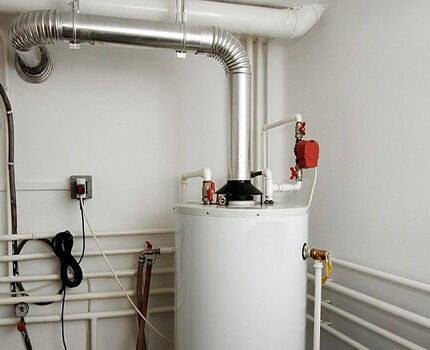
Installation of a water heater with any type of combustion chamber requires approval from the gas service. Considering that such equipment is potentially dangerous, an appropriate certificate must be issued for it, and specialists must be involved for its installation and further maintenance.
There are also special requirements for chimneys.
Comparison of electric and gas water heaters
Electric storage water heaters have a water tank volume of 10 liters or more.
They are more common than their gas counterparts for the following reasons:
- lower cost both the equipment itself and its installation;
- ease of installation — there is no need to coordinate installation and carry out maintenance with the mandatory involvement of certified gas service specialists;
- selection of installation location — there are no restrictions on the location of the unit;
- safety — electrical devices are less dangerous due to the absence of the need to use gas.
However, gas water heaters has its advantages, due to which it occupies its own segment of the storage water heater market:
- lower gas cost, as a source of energy, which, with significant volumes of hot water consumed, quickly pays off the cost of the equipment;
- high power and, as a result, faster heating of water;
- no load on the power grid — there are no special requirements for wiring.
Choice between gas and electric water heaters depends on many factors, primarily the structure of the house, the number of people living, installed communications and financial capabilities.

Main parameters of storage water heaters
Storage water heaters are quite complex devices, so it is necessary to analyze all the parameters in order to avoid problems with their operation. Most of the elements of gas and electric devices are identical, therefore the rules for their selection are the same.
Typing according to the method of water connection
In the absence of constant pressure in the water supply, non-pressure water heaters are used. In this case, water enters the tank using a special pump. It can be turned on and off automatically using a float switch integrated into the container.
If the pump has only manual control, then it is necessary to monitor the water level in the tank to avoid exposing the heating element. The same problem may occur if the device is used continuously for a long time if the volume of incoming liquid is less than the flow rate.
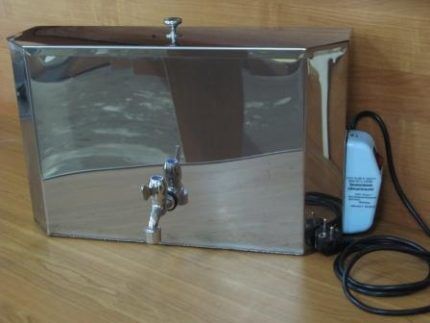
For plumbing systems with constant pressure, pressure-type water heaters are used. They can only be used with constant water pressure in the apartment or private house.
Compared to non-pressure devices, they have three significant positive aspects:
- durability of operation — the constant presence of water in the tank reduces corrosion of its internal surface and, thus, extends the service life of the device;
- there is no risk of exposing the heating element and its failure;
- significant hot water pressure at the outlet of the tank, the value of which is determined by the pressure in the water supply system.
It should be noted that the market is dominated by models of pressure-type storage water heaters. A wide selection of non-pressure devices is present only in the segment with a tank volume of up to 30 liters.
Rules for choosing tank volume
Tank volume is one of the main parameters when choosing a water heater. It determines the amount of hot water that can be used during the period of time before a new portion is heated to the required temperature.
There are various tables that can be used to roughly estimate the required volume depending on the number of people and types of hot water use.However, in such calculations, average indicators are used, so it is better to independently calculate the required tank volume, taking into account individual parameters.
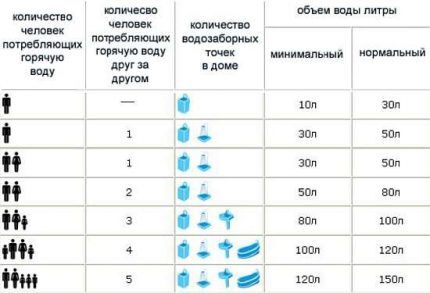
For example, the water flow rate for a medium-pressure shower is approximately 5 l/min. Of this, 2 l/min of hot water will be consumed. In this case, to carry out a procedure lasting 10 minutes, you need to spend 20 liters from the water heater.
For a family of four, taking a shower in the evening will take about 80 liters. Taking into account the need to wash dishes after dinner, brush teeth and other needs, the minimum volume of the water heater tank should be 120 liters of water.
When purchasing a storage water heater, it is better to choose a model with a tank volume slightly larger than calculated. It should be understood that the energy consumption to maintain the temperature of the “reserve” volume is insignificant compared to heating the consumed water.
The main problems with large devices are the speed of heating water and difficulties with placement.
Determining the required power
The speed of water heating depends on the power of the water heater. Gas devices, as a rule, are 2-3 times more powerful than their electric counterparts and therefore perform their main function faster. The passport or operating manual usually indicates the time it takes for a full tank to heat up.
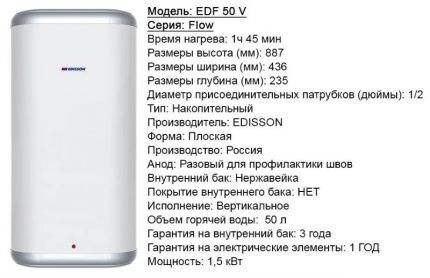
However, the temperature of the supplied cold water depends on the parameters of the water supply system, and the temperature of the output hot water depends on the wishes of the consumer. Knowing these two parameters, you can calculate the heating time yourself and, based on this, decide what power of a storage water heater is best for specific operating conditions.
To heat 1 liter of water by 1°C, you need to spend 1 kcal or 0.00116 kWh. Thus, for example, to heat 100 liters of water with a temperature of 10°C to 70°C at a device efficiency of 95%, 0.00116 * 100*(70-10)/0.95 = 7.33 kWh is required.
If the water heater power is 2 kW, then the heating time for a full tank will be 7.33 / 2 = 3.66 hours or 3 hours and 40 minutes.
When choosing an electric type of water heater, it is necessary to decide on the ability of the electrical network section to withstand additional voltage.
To do this you need to know power cable cross-section, the rated current of the circuit breaker and the possibility of replacing them if the maximum permissible power consumption of all devices in the circuit is exceeded.
The presence of several operating modes is an undoubted advantage of some models of storage water heaters. In this case, for one-time rapid heating of a large volume of water, it is possible to use maximum power.
When operating in normal mode, less power is used to maintain the temperature or heat small portions of incoming cold water, which does not put a large load on the home’s electrical network.
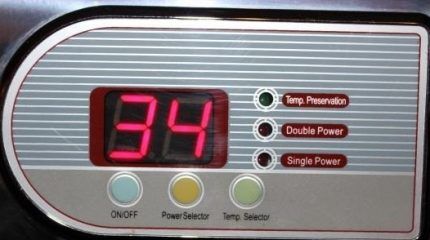
Electronic and mechanical control panel
An integral part of the storage water heater is the control and display panel. It is individual for each model and is available in mechanical or electronic versions.
Usually, with the correct choice of volume and power, the device’s operating parameters are configured upon first connection, and subsequently the use of the panel is minimal.
The touch-type electronic control panel has a fashionable design, but is more susceptible to breakdowns than a mechanical one. This is especially true for wet rooms.
Failure of at least one electronic element leads, as a rule, to stopping the operation of the entire water heater. Mechanical control is easier to repair and maintain, and is also cheaper.
Floor or wall placement
One of the main disadvantages of storage type water heaters is their size and weight. Therefore, unlike flow-through devices, it is necessary to find a place in advance and determine equipment installation procedure.
There are two main types of placement of large water heaters:
- wall mount used for water heaters up to 50 liters on any walls and up to 200 liters on durable ones;
- floor placement practiced when installing large-capacity devices, or if it is not possible to attach them to a solid wall.
Wall mounting can also be done in the absence of a solid wall. In this case, an additional frame resting on the floor is constructed, for example from metal corners, onto which the water heater is already attached.
Depending on the type of placement, different approaches to organizing cold water connections, hot water outlets, and access to gas or electricity are possible. Therefore, when choosing a water heater, it is necessary to clarify the method of its installation and methods connections to water supply.
Some models allow both wall and floor mounting options.
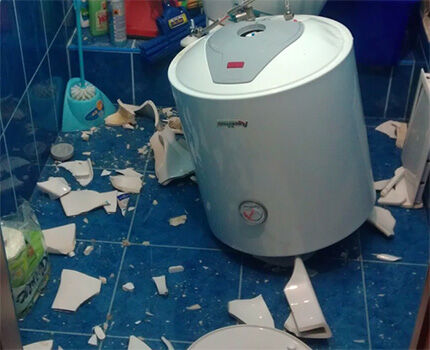
Types of hull shapes
When choosing the shape of the water heater body, they proceed primarily from the convenience of its placement in the room. There are devices of horizontal and vertical types.
The latest models are divided into several types:
- Cylindrical heaters are the most common and cheapest. This geometry provides the smallest surface area with equal volume relative to other types, and therefore requires less material for the tank, insulation and body.
- Rectangular devices Easy to place in a corner, or use as a built-in.
- Flat (slim) water heaters can be introduced into various niches and are quite easy to fit into any interior. However, from a functionality standpoint, this type of device is not the most economical, so they are more expensive than competitors with similar indicators.
When purchasing a water heater, you must take into account that it cannot be placed at an angle or, moreover, change the spatial orientation from horizontal to vertical or vice versa. When repairing or remodeling, you also need to remember this installation feature.
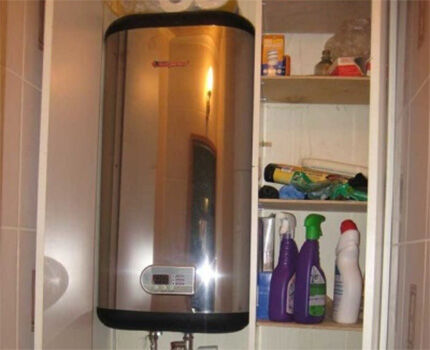
Protection of the internal surface from corrosion
The service life of a storage water heater tank largely depends on its internal coating. It is necessary to protect against temperature changes, as well as the effects of aggressive substances and oxygen contained in water.
All these factors are favorable for the occurrence of corrosion, which is the main reason for the failure of the water heater tank.
The cheapest models of water heaters use galvanized steel as the material for the tank. It should be noted that the service life of such devices is short, and the warranty period is usually one year.
Therefore, it is better to pay attention to more serious options for preventing corrosion, such as using stainless steel.
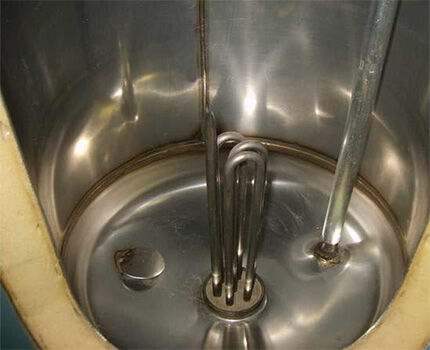
One popular solution is to apply special enamel or ceramics to the inside of the tank. However, for many types of such coatings there are restrictions on the maximum permissible temperature.
There are solutions based on enamel containing titanium (Ariston), aluminum (Electrolux), made of high-strength plastic (Dimplex) etc.
There have been no independent studies to compare their effectiveness, so the warranty period and consumer reviews of products from specific manufacturers can serve as a guide to reliability.
Service Features and Warranty
Manufacturers integrate a magnesium anode inside the tank in almost all models. As a rule, it is located in conjunction with an electric heating element, but sometimes it can be installed separately.
The anode performs two main functions:
- protects the inner surface of the tank from corrosion;
- softens scale that forms on the heating element rods.
In this case, the magnesium anode is gradually destroyed. Therefore for replacing the heating element, descaling and other procedures, periodic maintenance work is provided, the procedure for which is described in the user manual.
It is better to carry out such actions in the summer, because they require disconnecting the device from the water supply system. For many models, preventive maintenance can be performed independently, saving money on calling a specialist.
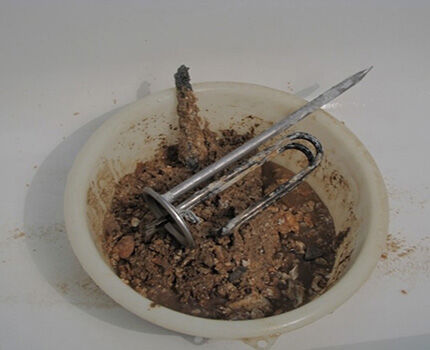
Warranty repair of a water heater tank may be denied due to (or under the pretext) lack of proper care for it.To avoid this, it is necessary to carry out preventive work on time, calling a specialist and documenting the procedures performed.
If the work was done independently, then you need to keep receipts for the purchase of consumables.
The exact conditions for free repair are specified in the warranty card or device passport. You need to familiarize yourself with them before purchasing it. One of these conditions may be mandatory servicing by calling a technician from a certified center, which is located far from the installation site of the device.
If the equipment is expensive and there is a risk of losing the warranty, then it is better to choose another option.
Conclusions and useful video on the topic
Analysis of the device of one of the gas-type models, manufactured by Ariston. Three ways to extend the life of your tank:
Scheme of operation of electric storage water heaters with different types of housing shapes:
Analysis of the main parameters of electrical water heating devices:
Information about the principle of operation and characteristics of a water heating device will help you choose the best option that meets the needs of the family and the financial capabilities of the owner of the house or apartment.
Do you have anything to add or have questions about choosing a storage water heater? Please leave comments on the post. The contact form is located in the lower block.




Last year we bought a 30 liter storage water heater. (taken temporarily), the brand was quite famous. Of the functions, it did not have heating control, but only one power button. Before purchasing, my husband and I looked at a table from which we can roughly determine the volume, and we got 30 liters.
It turned out that all this was complete nonsense! 30 liters is not enough for even one person to take a shower. It took a long time to heat up and the water drained quickly. My advice to you is to take a water heater of at least 80 liters for two people. Now we have a boiler and we are happy.
I was even wondering what table you looked at before purchasing. 30 liters is enough for one person to wash economically, or if water is needed more for household needs. For example, you can wash a lot of dishes.
If you want to wash comfortably, count on 50 liters. per person.
Hello. Here you didn’t have to look at any tables, but think logically and check before purchasing how many liters of water you use for washing. 30 liters is the volume of water heated to a certain temperature (in your case, already set on the heater). When diluted, we obtain the volume of water for washing. And here everything is individual. On average, according to statistics, 35 liters are enough for users. And my friends have such a heater, they say that half a tank is enough per person. 30 liters of boiling water is enough to fill a medium-sized bathtub, and the water will be hot even after dilution. But for the soul this may indeed not be enough.
When choosing a boiler, you should take into account the preferences of each family member - how long you stand in the shower, how many detergents you use (they also need to be washed off, for example, for the head only shampoo or shampoo, and then a balm/mask, a regular wash or an additional scrub, etc. .), how many people bathe during one heating, etc.
There is no need to treat storage water heaters as something that will work forever. In my opinion, if a water heater has worked for 5-7 years, this is already good. Now you just need to buy a new one. Of course, if the heating element in it burns out, then, as a rule, it is easy to replace it with a new one. But very often the tank itself, which is located inside, begins to leak, there’s nothing you can do about it. But this technique must be approached sensibly, since nothing lasts forever.